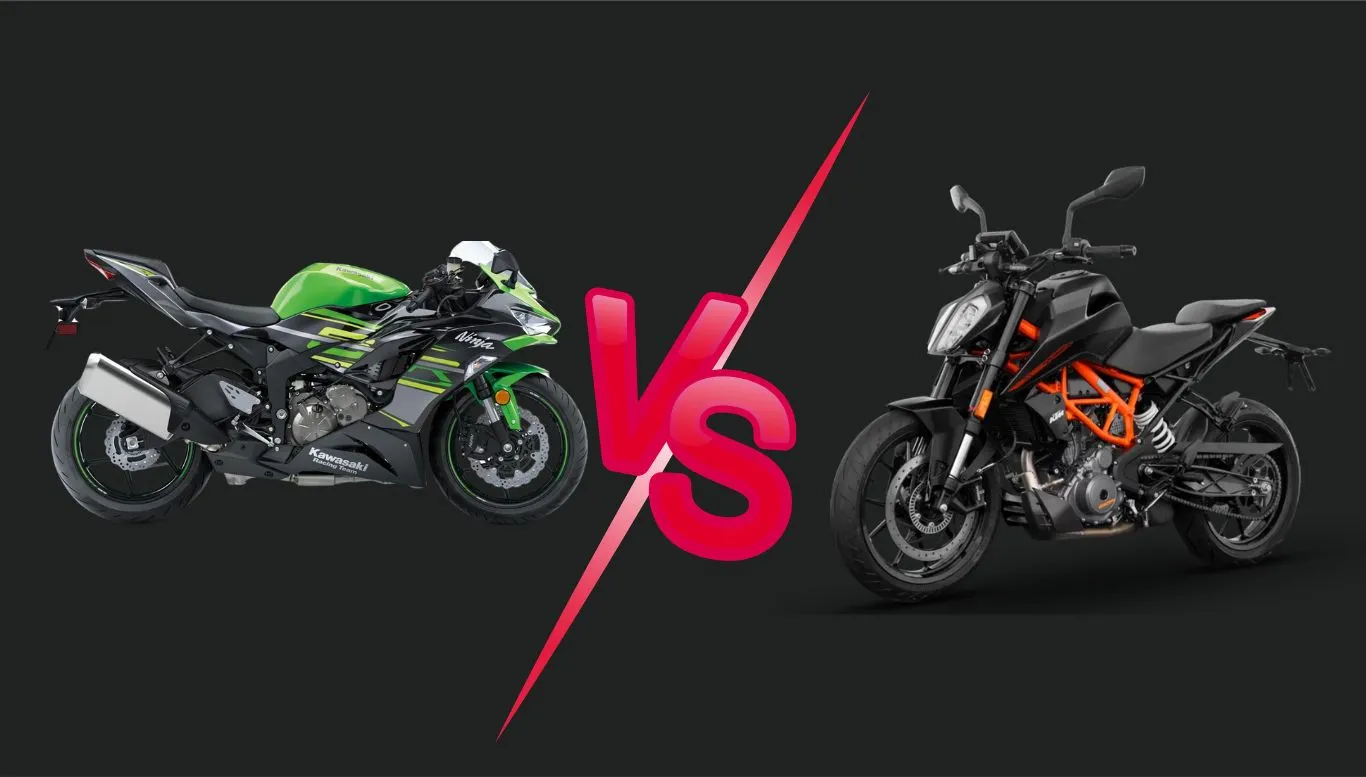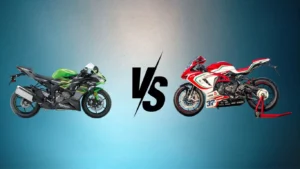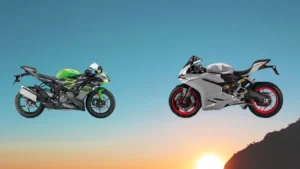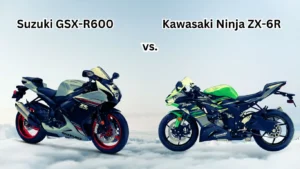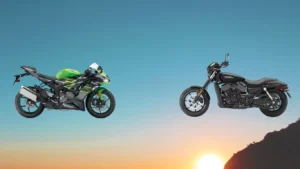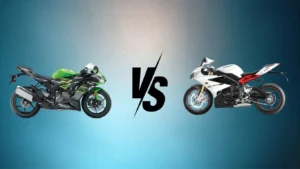Are you revved up and ready to evaluate two power-packed bikes that have been leaving rubber on asphalt across the globe? The Kawasaki Ninja ZX-6R and the KTM RC 390 have been staking their claim in the world of speed and agility. These muscular machines are not just about horsepower; they’re also about the sublime balance of power-to-weight ratio, agility, and handling, all of which give motorcycle enthusiasts the thrill of riding.
But as potential riders or just motorcycle admirers, wouldn’t you want to know which of these formidable bikes outshines the other? It’s a match-up that’s sure to quicken the pulse as we take these two feats of engineering, place them headlight to headlight, and run through the tell-tale numbers and rider feedback. So, fasten your helmets, as we’re about to dive into the dynamics of the Kawasaki Ninja ZX-6R versus the KTM RC 390.
Unveiling the Powerhouses: Kawasaki Ninja ZX-6R and KTM RC 390
Let’s dive into the robust world of motorcycling powerhouses – the Kawasaki Ninja ZX-6R and the KTM RC 390. These two beasts are undoubtedly two of the most admired and acclaimed machines in the biking fraternity. However, it’s not mere admiration that we’re dealing with here. Instead, we’re about to undertake a detailed dissection of these two machines, examining their power-to-weight ratios, agility, and handling. This is essential information for you, the reader, as it could greatly influence your choice between these two spectacular motorcycles.
Revealing the Powerhouses: The Basics
Before we jump straight into their power-to-weight ratios, let’s get familiar with these two bikes. The Kawasaki Ninja ZX-6R, introduced in 1995, is a mid-range sport bike from the Ninja series famed for its exceptional performance on the track and the road. On the other hand we have the KTM RC 390, launched in 2014, an entry-level sport bike that has earned a name for its excellent performance and value for money.
The Importance of Power-to-Weight Ratio
When evaluating the prowess of superbikes, the power-to-weight ratio can’t be ignored. This key parameter affects not only the bike’s speed but also its handling and fuel efficiency. A high power-to-weight ratio suggests that the bike has more power for its weight, contributing to superior acceleration and top speed. However, more power isn’t always better – the bike also needs to be able to handle this power effectively, which brings us to the aspect of handling and agility.
Handling and Agility – The Second Piece of the Puzzle
While power is important, a motorcycle’s handling and agility are crucial factors that determine how well the bike can be controlled and manoeuvred. This is especially important for sports bikes like the ZX-6R and RC 390, where the rider often has to make quick decisions and adjustments on the roadway or racetrack.
A Battle of Aerodynamics: Design Features of ZX-6R and RC 390
Lastly, one can’t overlook the aerodynamics and design features of these bikes. They play a significant role in enhancing performance, whether it’s reducing air drag for higher speeds or improving stability with better weight distribution. Each motorcycle has its unique design features, contributing to its signature performance and riding experience.
Kawasaki Ninja ZX-6R vs KTM RC 390: The Rider’s Verdict
So, which bike would be the better option for you? Well, that depends on your specific requirements and preferences as a rider. If you desire high-speed thrills on the racetrack, the raw power and superior aerodynamics of the Ninja ZX-6R may be your cup of tea. But, if you’re a beginner seeking valiant performance at a cost-effective price, the KTM RC 390 might be your perfect match.
Breaking Down the Power-to-Weight Ratio: Ninja ZX-6R
Unraveling the power-to-weight ratio of Kawasaki Ninja ZX-6R truly requires a deep dive into its engine capabilities contrasted against its sleek frame and weight. This golden ratio stands as a testament to the ZX-6R’s exceptional dynamism and mechanical prowess, begging us to explore just how this performance machine emerges victorious in power-to-weight equations.
Peerless Performance: The Engine and Power
The Kawasaki Ninja ZX-6R owes its power largely to its potent 636cc inline-four engine. This powerplant is renowned not only for its raw power, but also for delivering smooth and controllable torque at all rpm ranges. With an impressive power output of around 130 Horsepower, the ZX-6R leaves no stone unturned when it comes to performance on both city streets and racetracks.
A Featherweight Contender: The ZX-6R’s Weight
Despite its powerful engine, the Ninja ZX-6R maintains a relatively lightweight profile. It tips the scales at approximately 196kg, thanks to its light but robust aluminum frame. This blend of power and controlled weight consolidates the bike’s high power-to-weight ratio.
Uncovering the Ratio: Power-to-Weight Triumph
When we combine the output of the formidable engine with the motorcycle’s weight, we reveal the true power-to-weight ratio of the Ninja ZX-6R. This ratio is intrinsic to the bike’s performance, offering both speed and efficiency. With such a respectable engine performance weighed against its trim design, the Ninja ZX-6R proudly boasts a high power-to-weight ratio, delivering a ride that is both exhilarating and controlled.
Decoding the Impact: Affect on Ride Dynamics
Quite simply, a high power-to-weight ratio equates to increased acceleration and swift performance, which is true for the Ninja ZX-6R. The balance of this sturdy yet nimble machine ensures a ride that is all about optimal speed, razor-sharp cornering, and a compelling response to the call of the throttle, marking the Ninja ZX-6R as a true leader in its class.
Exploring the Power-to-Weight Ratio: RC 390
Turning our focus to the KTM RC 390, a lightweight behemoth in its own class, a definitive look at the engine, power, and weight characteristics playing a key role in its power-to-weight proportions is imperative. As we delve beneath the bike’s muscular facade, we discover the factors contributing to the ride dynamics that have made the RC 390 a favorite among bike enthusiasts.
Singular Performance: The Brilliance of the RC 390’s Engine and Power
The RC 390’s engine is a marvel of engineering, homing in on KTM’s commitment to compact and high-performance design. Its lightweight single-cylinder, 4-stroke-engine delivers exceptional power output, providing the rider with a thrilling riding experience. The bike’s power delivery is notable, giving the rider access to a robust torque curve across the RPM range.
Embodying Lightness: KTM’s RC 390 Weight Analysis
The RC 390’s weight is another strength that lends itself to the bike’s impressive power-to-weight ratio. Its innovative and lightweight frame design contributes greatly to the bike’s nimbleness and maneuverability on both track and road. This significantly amplifies the bike’s overall performance, providing the rider with a seamless and exhilarating riding experience.
The Crucial Factor: Power-to-Weight Ratio Realized
The resultant power-to-weight ratio of the RC 390 is exemplary, sitting prominently among its class. This high power-to-weight ratio provides the bike with commendable acceleration and responsiveness. Essentially, it allows the bike to leverage every bit of its power in the most efficient way possible, thereby ensuring thrilling yet controllable rides.
Translating to the Tarmac: Ride Dynamics of the RC 390
When it comes to ride dynamics, the power-to-weight ratio is the heartbeat of the RC 390. It translates directly to superior acceleration, improved handling, and overall enhanced performance. Whether navigating city streets, embarking on long road trips, or tackling tight turns on the racetrack, the RC 390 shines due to its impressive power-to-weight balance.
Responsiveness at your Fingertips: The Throttle and Ride Control
The throttle and ride control is a key element in the riding experience on any bike, directly influencing its agility, handling, and responsiveness. Both Kawasaki Ninja ZX-6R and KTM RC 390 offer an impressive throttle management system complemented by an amazing set of ride control features that enhance the responsiveness of these machines, making your ride smoother and more enjoyable. Let’s dive into the nuances.
Dialing up the Response: The Throttle System
The throttle ramp-up of the Kawasaki Ninja ZX-6R is superlative, handling variation of engine power with surprising ease. Twists and turns become effortless pursuits—a celebration of the ZX-6R’s superior engineering. Similarly, the KTM RC 390 does not lag; its smooth throttle response and excellent power delivery at all rpms make city riding and handling traffic situations a breeze.
Sophisticated Ride Control: Making the Difference
On the Ninja ZX-6R, the extraordinary ride control features such as adjustable traction control, ride modes, and anti-lock braking system work together to provide riders both safety and a thrilling experience. On the other hand, the KTM RC 390’s ride by wire, slipper clutch, and quickshifter system render it a sports bike par excellence, blurring the line between street and racetrack riding.
Two Machines, Same Goal: Supreme Responsiveness
Both the ZX-6R and the RC 390 seem to get it right in terms of throttle response and ride control—crucial aspects that optimize the ride quality, power management, and overall rider satisfaction. These aspects contribute largely to their respective agile, responsive natures.
Balance of Power: Rider Control vs Bike Performance
At the end of the day, it all boils down to how well the rider can control the machine. The ZX-6R and RC 390, with their superior throttle and state-of-the-art ride control systems, strike a perfect balance between bike performance and rider control, enhancing not just the riding experience, but also the overall safety and rider confidence.
The KTM RC 390 and Kawasaki Ninja ZX-6R: A Comparative Study
When it comes to swiftness and agility on asphalt, the specifics of performance for any motorcycle like power-to-weight ratio, handling, and aerodynamics carry significant weight. This evaluation puts the KTM RC 390 and Kawasaki Ninja ZX-6R under scrutiny, breaking down their performance and handling to offer you a comprehensive comparison.
Measuring Up: Power-to-Weight Ratio
The power-to-weight ratio differs significantly between these two contenders, being intrinsically tied to their engine output and weight. The Kawasaki Ninja ZX-6R, with its larger 636cc engine, naturally boasts greater power. However, the KTM RC 390, being considerably lighter, makes up for its smaller 373.2cc engine, maintaining a competitive power-to-weight ratio. Both machines provide impressive thrust, albeit in markedly different ways due to their weight and torque distribution differences.
Maneuverability: Unpacking the Handling
The handling of a motorcycle is a crucial factor when evaluating its performance. It characterizes how the bike responds to the rider’s commands and the ease at which corners can be navigated. The ZX-6R offers nimble control due to its high-speed stability and supportive suspension system, while the lightweight RC 390 delivers crisp, quick responses, allowing for sharp turns and switchbacks with ease.
Aesthetic Efficiency: The Role of Aerodynamics
Aerodynamics play a profound role in both machines’ performance capabilities. Both the ZX-6R and RC 390 embody sleek, wind-cutting designs that not only embody sports aesthetics but also enhance acceleration and top speeds. The ZX-6R, for instance, features an aerodynamic fairing and strategically placed vents that reduce drag. The RC 390, nearing on minimalistic, keeps wind resistance to a minimum with its feather-light stature and streamlined design.
Turning the Tables: Rider Control vs Bike Performance
Rider control and bike performance achieve a delicate balance in both these motorcycles. The ZX-6R offers multiple riding modes and adjustable traction control, giving the rider higher command over the ride dynamics. The RC 390, on the other hand, makes up for its lack of versatile control settings with its lightweight and nimble handling characteristics, providing an adrenaline-filled ride with an intimate feel of the road.
Speed vs Stability: Ninja ZX-6R and RC 390’s Handling
Navigating the emotional rush of pure speed against the necessity of stark stability is a delicate high-wire act. So, let’s evaluate and contrast how this balance is managed by two incredible machines: Kawasaki’s Ninja ZX-6R and KTM’s RC 390.
On the Razor’s Edge: Ninja ZX-6R Handling
It’s no surprise that the Ninja ZX-6R, with its race-derived chassis and advanced electronics, demonstrates sublime handling. It offers levels of stability and confidence at incredibly high speeds that would be enviable by any of its rivals. Ease in switching directions and precision in carving corners makes for an exhilarating riding experience.
Swift and Steady: The Nimbleness of the RC 390
But let’s not underestimate the handling prowess of the KTM RC 390. The compact design and lightweight character of this bike make it immensely agile. It seems to have a knack for quick direction changes, hugging tight corners with ease and stability, making it a pleasure to maneuver in both city traffic and twisty country roads.
A Long-Distance View: Touring Capabilities
In terms of long-distance riders, the handling of the Ninja ZX-6R tends to be more forgiving, the considerable weight allows for a steady and planted feel on highways. On the other hand, the lightweight nature of the RC 390 can make it slightly uncomfortable during long rides; however, the nimble handling characteristics make up for this on challenging roads.
Bracing for Impact: Suspension and Ride Quality
In terms of suspension, both Kawasaki’s Ninja ZX-6R and KTM’s RC 390 have adjustable front and rear suspensions. The Ninja ZX-6R features high-quality Showa separate function front forks and a mono-shock on the rear end, while the RC 390 sports WP forks and a mono-shock on the rear. Both deliver respectable ride quality, with the Ninja ZX-6R leaning towards a plush ride and the RC 390 offering a slightly stiffer, sportier feel.
Behind the Wheel: Ninja ZX-6R’s Exceptional Handling
Get ready to dive into the intricate ballet of torque and tire, the refined equilibrium of speed and control – the handling of the Kawasaki Ninja ZX-6R. Famed for its agile and responsive nature, the ZX-6R promises to deliver an exhilarating ride experience. Guided by rider-friendly technologies and high-performance components, it’s an engineered marvel of fluid athleticism and sharp precision.
Masterful Maneuverability: The Clout of the ZX-6R
The ZX-6R’s handling is where the magic truly comes alive. Blessed with an ultra-responsive throttle, and backed by a short-wheelbase chassis and sophisticated suspension setup, the Ninja is a masterclass in maneuverability. Whether you’re carving tight city corners or taking on the open highway, this machine remains unfazed, giving riders the confidence to explore the extremes.
Quality of Ride: Absorbing the Shock
While the Ninja’s handling might be sports-grade, its ride quality doesn’t trail far behind. Equipped with advanced Showa suspension, the ZX-6R effortlessly smoothes out road imperfections, providing a glide-like ride even on patchy surfaces. The balance between stiff handling and plush comfort is exactly where it needs to be, ensuring riders can push the boundaries without compromising on ride comfort.
Taming the Beast: ZX-6R’s Electronics Aiding Handling
What sets the ZX-6R apart is its sophisticated suite of electronics savvily designed to provide rider-friendly handling. With traction control allowing for a safer power delivery and corner management system ensuring absolute control, this Ninja tames the torque-rich beast that it houses, providing an intuitive, dynamic ride that suits both amateur and seasoned riders alike.
KTM RC 390: A Deep Dive into its Superb Handling
An Exploration into RC 390’s Handling
When it comes to the handling of KTM’s RC 390, superb is a fitting choice of adjective. The motorcycle’s maneuverability, coupled with both its stability at high speeds and agility during tight corners, transforms every ride into a riveting experience. Let’s delve deeper to understand what makes the RC 390’s handling so exceptional.
The Mastery Behind its Maneuverability
The KTM RC 390’s light weight, coupled with its potently powerful engine, results in a level of maneuverability that sets a high bar in the motorcycling world. The bike responds effortlessly to the rider’s inputs, allowing for precision control. Its agile frame also makes quick direction changes a breeze, transforming every twist and turn into a thrilling experience.
Stability at High Speeds: A Defining Attribute
Crossing the high-speed threshold is where the KTM RC 390 truly shines. Its aerodynamically engineered design reduces wind resistance to the bare minimum. It goes without saying, the balance and stability provided by the combined effect of aerodynamic design and suspension system enable riders to maintain control, even at spine-tingling speeds.
Agility for Cornering: Weaving Through like a Pro
Many motorbikes face considerable challenges when it comes to tight cornering. However, the KTM RC 390 makes light work of sharp bends with its impressive agility. The well-harmonized combination of a short wheelbase and precise steering geometry bring into life an unerring precision that makes challenging hairpin bends a joy to navigate. Its suspension system further contributes to this, providing pliancy and control, and creating a ride that is as close to effortless as it gets.
Final Verdict: A Stand-out Performer
A holistic overview of the KTM RC 390 reveals a motorcycle that has been engineered for exceptional handling. Whether it’s the agility for difficult corners, the stability at high speeds, or the precision control in all situations, the RC 390 delivers an unparalleled riding experience. In summary, those who prioritize superior handling in their ride will find the KTM RC 390 a match made in heaven.
Kawasaki Ninja ZX-6R and KTM RC 390: A Battle of Aerodynamics
You’re likely to be torn between two formidable adversaries when it comes to sports bikes – the Kawasaki Ninja ZX-6R and the KTM RC 390. One aspect that separates them and gives one the edge over the other is their aerodynamics. Let’s put these two under the microscope, evaluating their aerodynamics and the role it plays in shaping their performance.
Flying Through the Air: Aerodynamics of the Ninja ZX-6R
The ZX-6R’s aerodynamic design can be attributed to years of Kawasaki’s involvement in the world of motorsports. It’s an incredibly streamlined machine. The low-slung, pointed front, coupled with the sharp lines running across the body maintains the aerodynamic consistency while enhancing aesthetics. The diminutive windscreen diverts the airflow around the rider, reducing drag and ensuring the ZX-6R cuts through air like a hot knife through butter.
Elevation Through the Breeze: KTM RC 390’s Aerodynamic Prowess
KTM has always centered its designs on being functional rather than aesthetic. The RC 390 follows suit, offering an aerodynamic design that is distinctive. With an aggressive front end and faring, it’s optimally positioned to reduce air drag. The sloping tank and the tail, apart from offering better handling, contribute to the overall aerodynamic nature. The tall windscreen keeps the air off the rider, ensuring a stable and turbulence-free ride even at higher speeds.
The Significance of Aerodynamics: Molding Performance and Fuel Efficiency
Excellent aerodynamics not only provide stability and decrease wind drag at high speeds, but also greatly enhance a bike’s fuel efficiency. By reducing air resistance, arias with superior aerodynamics can maintain high speeds without demanding too much from the engine. Thus, a bike like the Ninja ZX-6R or RC 390 with impressive aerodynamics also comes with the promise of better fuel efficiency. This aspect, often overlooked, is now recognized as an essential trait in sports bikes.
The Wind Tunnel Test: Real-world Scenario
There could be a stark difference between theory and reality when scrutinizing aerodynamics – a factor that strikes a balance between speed, stability, and efficiency. Both the Ninja ZX-6R and the KTM RC 390 are noteworthy, yet their on-road performance in terms of aerodynamics could contradict the spec-sheet. While the ZX-6R might cut through winds effortlessly, the RC 390’s unique design might create turbulence at certain speeds. Understandably, it’s about personal experience as each rider can perceive aerodynamics somewhat differently.
Decoding the Unique Design Features of Ninja ZX-6R and RC 390
As motorcycling enthusiasts, we understand that the devil is in the details. In the high-speed world of motorbikes, those details often manifest in unique design features. Let’s dive into those defining characteristics that set Kawasaki’s Ninja ZX-6R and KTM’s RC 390 apart.
Eye-Catching Elegance: Ninja ZX-6R’s Design Aesthetic
The Ninja ZX-6R brings together a blend of sleek sophistication and aggressive styling, a definite head-turner on the roads. It sports dual LED headlights and exact bodywork contours, contributing to both aesthetics and aerodynamics. For comfort, it features ergonomically designed seats and handlebars, subtly emphasizing functionality without compromising on the visual appeal.
Slippery Aerodynamics: The RC 390’s Sculpted Silhouette
In contrast, the RC 390 delivers a racing-breed styling, derived straight from its track origins. Its downswept design, complete with an aerodynamic front fairing, contributes significantly to cutting through the wind at high-speed maneuvers. Complementing this is a compact tail section and a low-slung exhaust, reinforcing the sporty aesthetics while adhering to the concepts of weight distribution and balance.
Function Meets Fashion: Unique Functional Design Elements
Design is not merely a visual element in these bikes; it also plays a crucial role in their performance. The Ninja ZX-6R incorporates a ram-air intake to enhance performance, while the RC 390 features an innovative trellis frame for improved handling. These functional design elements are seamlessly integrated into their aesthetics, striking an adaptable balance between form and function.
Attention to Detail: Intricate Features Add Distinct Personality
Looking closer, we see thoughtful details that add to the unique personality of both bikes. The ZX-6R, for instance, has a digital-analog combo instrument cluster that offers comprehensive information in a glance. The RC 390, on the other hand, boasts backlit switchgear buttons, a rarity in this class, offering easy identification even in low-light situations. It’s these subtle yet significant design features that push these machines ahead of the pack.
From the Racetrack to the Roads: Ninja ZX-6R and RC 390
Spotlighting the racetrack legends – the Ninja ZX-6R and RC 390, these powerful machines have been successful in translating their track dominance to the streets. A juxtaposition of their adaptability from the incredibly high-stakes environment of professional racing to everyday roads unveils nuanced aspects about their engineering, design, and overall performance.
Dominance on the Racetrack: The genetic lineage of ZX-6R and RC 390
The Ninja ZX-6R and the RC 390 were bred on the racetrack, and they embody the racing DNA in their every aspect. Their design, speed, handling, and aerodynamics are a result of intense development cycles designed to squeeze out every ounce of performance on the track.
Album of Achievement: Podium Finishes and Championship Titles
The ZX-6R and the RC 390 have had their fair share of podium finishes and championship titles. This history of achievement has undeniably influenced their design and performance characteristics, making them exceptional machines on and off the track.
Diluting the Intensity: Adapting for Everyday Roads
While these motorcycles come from a rich racing bloodline, they’ve been adeptly adapted to everyday road conditions without significantly compromising their racetrack bred performance. Adjustments in throttle response, suspension settings, and ergonomics have made them more approachable and rider-friendly in daily life scenarios.
Road-Ready Refinements: Comfort Meets Power
The ZX-6R and RC 390’s road adaptations prioritize rider comfort alongside power delivery. Thanks to revised seat shapes, adjustable handlebars, and nuanced weight distribution, these bikes offer an enviable blend of comfort and performance for their riders.
Democratizing the Racetrack Experience: Bringing Superbikes to the Streets
Both Kawasaki and KTM have achieved a rare feat by bringing the superbike experience, usually confined to the racetrack, to the streets. This evolution has made the breathtaking power, intense maneuverability, and sharp reflexes of track machines accessible to an expanded rider base.
Riding Experience: Ninja ZX-6R vs KTM RC 390
Embarking on a thrilling ride on two wheels is an exciting affair. The exhilaration grows when you straddle the likes of the Kawasaki Ninja ZX-6R or the KTM RC 390. However, the riding experience of these two powerhouses can vary significantly based on various factors such as rider comfort, ergonomics, and the design of the controls. Let’s delve deeper into what these motorcycling mammoths have to offer in terms of ride quality and comfort.
Rider Comfort: Ninja ZX-6R
Kawasaki has always nailed rider comfort and the ZX-6R is no exception. The motorcycle offers a well-padded seat that provides ample comfort for both the rider and the passenger. The specially calibrated ergonomics of the ZX-6R ensure that riders, regardless of their size, can maintain a comfortable riding position, even on long hauls.
Control Design: ZX-6R
The ZX-6R features an easily reachable handlebar and footpegs, that make controlling the bike effortless and intuitive. Furthermore, the motorcycle’s instrument panel communicates essential information to the rider clearly and effectively, contributing to a better riding experience.
Rider Comfort: RC 390
The KTM RC 390’s compact and stylish design might seem intimidating to some, but the bike’s ergonomics are designed to cater to a gamut of riders. The seat is generous, providing good comfort levels, and the riding position is sporty yet comfortable, reflecting KTM’s iconic racing DNA.
Control Design: RC 390
Much like Kawasaki, KTM also scores high on control design. The RC 390’s handlebar, footpegs, and control layout are designed to be rider-friendly. Its backlit switchgear and clear instrument panel add to the positive riding experience by making riding, especially during night time, a breeze.
Final Verdict on Riding Experience
The Kawasaki Ninja ZX-6R and the KTM RC 390 are closely matched when it comes to providing an excellent riding experience. In the realm of comfort, control design, and ergonomics, both bikes shine bright, offering riders the thrill of motorcycling, without compromising on comfort and control.
Motorcycling Enthusiast’s Guide: Kawasaki Ninja ZX-6R vs KTM RC 390
Let’s dive into the world of powerful bikes and get into the nitty-gritty of two titans in the motorcycle industry: the Kawasaki Ninja ZX-6R and the KTM RC 390. Our focus will be on contrasting their power-to-weight ratio, agility, handling, and design features among other key performance indicators. This comprehensive analysis aims to assist you, as a motorcycle enthusiast, to understand each machine’s intricacies and possibly help you choose your next ride. Strap in, it’s going to be a thrilling ride!
Breaking Down the Engines: Power Generation
The power generation in both the Kawasaki Ninja ZX-6R and the KTM RC 390 is the result of innovations in modern engine technology. These bikes boast high-performing engines that can generate immense power through meticulously designed mechanical intricacies. Let’s explore each engine, dissect their power output, and see what sets them apart.
A Game of Ratios: Decoding the Power-to-Weight Phenomenon
Understanding the power-to-weight ratio is crucial in comprehending the potential of these bikes. This ratio signifies the overall performance capabilities of the bike, providing insights on their acceleration and top speed. Here, we delve into the weights of both machines and how that translates into their privileged power-to-weight ratios.
More Than Momentum: Understanding Handling and Agility
Handling and agility are crucial design elements when it comes to the ride and control of a motorbike. The prowess with which a bike can be maneuvered directly impacts rider satisfaction. In this segment, we compare the handling and agility of the Kawasaki Ninja ZX-6R and the KTM RC 390.
Flight Without Wings: Aerodynamics and Design
Aerodynamics isn’t just important for airplanes; it plays a significant role in motorbike design too. The aerodynamics of a bike can influence its handling, fuel efficiency, and maximum speed, among other things. We’ll shed some light on the unique aerodynamic designs of both these motorcycles.
Conclusion
In conclusion, both Kawasaki Ninja ZX-6R and KTM RC 390 bring impressive features to the table, presenting motorcycling enthusiasts with tough choices. Their power-to-weight ratios, agility, and handling capabilities each have unique strengths, making each bike a standout in its own right.
When it ultimately comes to making a choice, it boils down to the rider’s personal preference and riding style. Whether it’s the sleek aerodynamics of the ZX-6R or the nimble handling of the RC 390, each bike offers an exceptional riding experience, promising power and control where it matters most.
